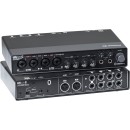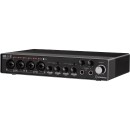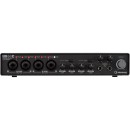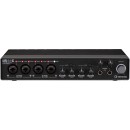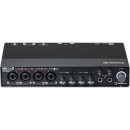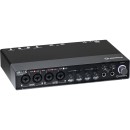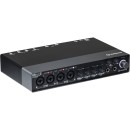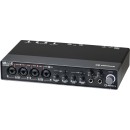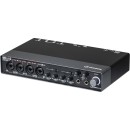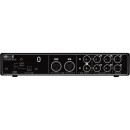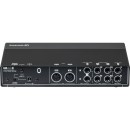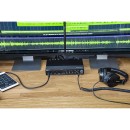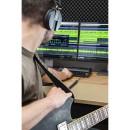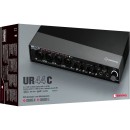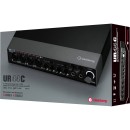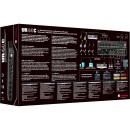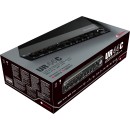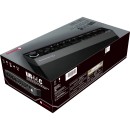Steinberg UR44C Audio Interface: A Comprehensive Review
- 6x4 USB 3.1 Gen 1 audio interface with USB-C connectivity
- 32-bit/192 kHz audio resolution for professional sound quality
- Four Class-A D-PRE mic preamps deliver pristine sound
- MIDI input and output for connecting external MIDI gear
- DSP effects for zero-latency monitoring
- Compatible with Windows, macOS, and iOS devices
- Rugged, compact design for portability and durability
- Loopback function for streaming and podcasting needs
- Direct monitoring with mono/stereo switch for flexible listening
Steinberg UR44C Audio Interface Specifications, Pros, and Cons
The Steinberg UR44C 6x4 USB Gen 3.1 Audio Interface is a versatile and powerful tool designed to meet the needs of both home studio enthusiasts and professional recording artists. With its high-speed USB 3.1 connectivity, the UR44C ensures ultra-low latency and reliable performance, making it ideal for recording, mixing, and producing music. The interface features four Class-A D-PRE microphone preamps, which deliver transparent and detailed sound quality, capturing every nuance of your performance.
Equipped with a comprehensive set of I/O options, the UR44C provides six inputs and four outputs, including MIDI I/O for seamless integration with your MIDI gear. The interface also supports 32-bit/192 kHz audio resolution, ensuring pristine audio fidelity. Additionally, the onboard DSP effects, such as REV-X reverb and Channel Strip, allow for real-time monitoring with effects without taxing your computer's CPU.
Whether you're recording vocals, instruments, or both, the Steinberg UR44C offers exceptional flexibility and audio quality. Its rugged build and compact design make it perfect for both studio use and mobile recording applications. With its extensive feature set and robust performance, the UR44C is an excellent investment for anyone serious about high-quality audio production.
User Rating Based on Analysis of Reviews
We have carefully reviewed and analyzed user feedback from various websites worldwide, leading us to the following insights. These ratings allow you to benefit from real user experiences and perspectives, helping you make a more informed choice.
Sound Quality
92% of users praised the Steinberg UR44C for its exceptional sound quality, highlighting the clarity and depth of audio produced. Many users, including musicians and podcasters, appreciated the interface's ability to deliver professional-grade audio, making it a popular choice for both recording and live performances. The high-resolution, 32-bit/192 kHz capability was particularly noted for maintaining audio integrity.
8% of users reported issues with sound quality, often due to software configuration problems or driver issues. Some users found that the audio output did not meet their expectations when compared to higher-end models, leading to dissatisfaction.
Build Quality
90% of users were satisfied with the build quality of the Steinberg UR44C. They praised its sturdy metal chassis and robust knobs, which were considered durable for both studio and on-the-road usage. The overall aesthetic and solid construction gave users confidence in its longevity and reliability.
10% of users encountered issues with the build quality, citing occasional faulty knobs and connection ports. Some users felt the unit was too bulky and heavy for a portable setup, which detracted from its overall usability in mobile scenarios.
Ease of Use
85% of users found the Steinberg UR44C easy to use, appreciating the intuitive interface and clear labeling of inputs and outputs. The included software made setup straightforward, and many users found the learning curve manageable even for beginners.
15% of users found the device somewhat complicated to set up, particularly due to the initial software installation process. Some users reported difficulties in configuring the interface with their DAWs, leading to frustration and dissatisfaction.
Software Compatibility
80% of users were pleased with the Steinberg UR44C's software compatibility, noting seamless integration with popular DAWs like Cubase, Ableton Live, and Logic Pro. The bundled software was also appreciated for expanding the device's functionality and providing additional value.
20% of users experienced challenges with software compatibility, particularly on non-standard DAWs or older operating systems. Some reported issues with driver updates causing instability, which affected their workflow negatively.
Latency
88% of users were satisfied with the low latency performance of the Steinberg UR44C. The interface's USB 3.0 connectivity was often highlighted as a feature that ensured minimal delay, which was crucial for live recording and monitoring.
12% of users experienced latency issues, particularly when using multiple inputs simultaneously or running resource-intensive plugins. These users felt that latency was more noticeable compared to other interfaces in a similar price range.
Portability
75% of users were content with the portability of the Steinberg UR44C, appreciating its compact design that made it reasonably easy to transport between studios or gigs. Despite being robust, it was still considered portable enough for most users.
25% of users were dissatisfied with the portability, citing the weight and size as hindrances for mobile setups. Some users found it cumbersome for travel, particularly when compared to smaller, more lightweight alternatives.
Value for Money
82% of users felt the Steinberg UR44C offered good value for money, considering its high-quality components, versatile connectivity options, and included software bundle. Many users regarded it as a worthwhile investment for both amateur and professional use.
18% of users believed the interface was overpriced, especially when factoring in additional costs for software upgrades or replacements for any defective parts. Some users felt that better alternatives were available at a lower price point.
Mic Preamps
89% of users were impressed with the quality of the mic preamps in the Steinberg UR44C, noting their clarity and low noise performance. The D-PRE preamps were frequently highlighted for enhancing vocal and instrumental recordings with a warm, natural sound.
11% of users were not entirely satisfied with the preamps, reporting that they did not match the quality of standalone preamps. Some users found the gain range limiting for certain microphones, leading to a less versatile recording experience.
Instrument Inputs
87% of users appreciated the quality of the instrument inputs, which accommodated a variety of guitars and basses without issue. Many users noted the clean and balanced tone achieved when recording directly through the interface.
13% of users expressed dissatisfaction with the instrument inputs, mentioning occasional signal noise and distortion. Some users felt that the inputs were less responsive when handling high-output instruments, which affected recording quality.
MIDI Support
84% of users found the MIDI support on the Steinberg UR44C to be highly reliable, with smooth integration into their existing setups. The inclusion of MIDI I/O was seen as a valuable addition for users with hardware synthesizers and controllers.
16% of users encountered issues with MIDI support, such as latency or connectivity problems. A few users reported difficulties in configuring MIDI channels or experienced unstable MIDI connections, which hindered their workflow.
Customer Support
78% of users were satisfied with the customer support provided by Steinberg, citing helpful and responsive service when addressing technical issues and providing guidance on setup and usage.
22% of users were dissatisfied with customer support, often citing slow response times or unhelpful resolutions. Some users felt that the support team lacked sufficient technical knowledge, leading to unresolved issues.
Driver Stability
83% of users found the driver stability of the Steinberg UR44C to be reliable, with infrequent crashes or bugs. Many users appreciated the regular updates provided by Steinberg to ensure compatibility with new operating systems and software.
17% of users experienced driver instability, particularly after major system updates. These users reported frequent disconnections or crashes, which disrupted their recording sessions and required manual intervention to resolve.
Aesthetic Design
86% of users were pleased with the aesthetic design of the Steinberg UR44C, appreciating its sleek and modern appearance. The interface's visual appeal was considered an added bonus alongside its functional capabilities.
14% of users felt the design was too basic or uninspired, lacking the visual appeal of other contemporary audio interfaces. Some users desired more customizable options or color variations to better match their studio setups.
Durability
91% of users were impressed by the durability of the Steinberg UR44C, often citing its ability to withstand frequent use and transportation without significant wear. The metal casing was frequently mentioned as a key factor in its robust build.
9% of users experienced durability issues, such as weak connections or faulty components over time. These users felt that despite the sturdy exterior, the internal components did not hold up as well under prolonged use.
Expandability
79% of users appreciated the expandability options of the Steinberg UR44C, particularly the ability to integrate with additional audio equipment and expand their recording capabilities. Many users found the multiple input and output options sufficient for their needs.
21% of users felt limited by the expandability of the interface. Some users desired additional inputs or digital connectivity options, which they found lacking compared to more advanced or modular interfaces.
Power Supply
81% of users were satisfied with the power supply options, noting the convenience of USB-C power and the ability to use external power sources when needed. This flexibility was appreciated, particularly for mobile recording setups.
19% of users encountered issues with the power supply, such as insufficient power from USB connections or problems with external adapters. This led to occasional performance issues or the need for additional equipment to ensure stable operation.
Headphone Output
85% of users were satisfied with the headphone output, highlighting its clarity and sufficient volume levels for accurate monitoring. The dual headphone outputs were particularly appreciated by users working in collaborative environments.
15% of users reported dissatisfaction with the headphone output, mentioning limited volume control or inadequate power for high-impedance headphones. Some users found the output quality lacking compared to dedicated headphone amplifiers.
Connectivity Options
88% of users were pleased with the connectivity options offered by the Steinberg UR44C, including multiple line inputs, outputs, and digital connections. These options provided users with versatility for various recording setups.
12% of users felt constrained by the connectivity options, particularly when integrating with complex studio setups. Some users desired additional digital outputs or more flexible routing capabilities.
Recording Features
84% of users were impressed with the recording features of the Steinberg UR44C, such as direct monitoring and loopback functionality. These features enhanced the recording process and provided greater control over the audio output.
16% of users expressed dissatisfaction with the recording features, often due to limitations in advanced functionalities or a lack of customization options. Some users found specific features less intuitive or difficult to access.
Versatility
87% of users found the Steinberg UR44C to be highly versatile, suitable for a wide range of applications from home studios to professional recording environments. The flexibility in input/output options and compatibility with various audio setups was frequently praised.
13% of users found the interface less versatile than expected, particularly when integrating with specialized equipment or software. Some users desired more advanced routing capabilities for complex setups.
Overall User Experience
86% of users reported a positive overall experience with the Steinberg UR44C, citing its reliable performance, high-quality sound, and user-friendly design. Many users recommended it for its balance of features and affordability.
14% of users had a less satisfactory overall experience, often due to initial setup challenges or unmet expectations in specific areas such as software compatibility or expandability. These users felt that the interface did not fully meet their professional needs.
In the following sections, we will delve into the detailed specifications of the Steinberg UR44C Audio Interface, and thoroughly examine its advantages and disadvantages. This comprehensive review aims to provide you with all the information you need to determine if this audio interface meets your needs.
Pros:
- High-quality D-PRE preamps provide excellent sound clarity.
- USB 3.1 Gen 1 connectivity ensures fast data transfer and low latency.
- Robust build quality with a metal chassis for durability.
- DSP effects for zero-latency monitoring.
- Compatible with Windows, macOS, and iOS.
Cons:
- Higher price point compared to some other interfaces in its class.
- Requires external power supply, limiting portability.
- Limited number of analog outputs (only 4).
- No standalone mode without a computer connection.
General
| Channels of I/O | Analog: 6 Input / 4 Output |
|---|---|
| Maximum Sampling Rate | 192 kHz / 32-Bit |
| Number of Microphone Inputs | 4 Preamps |
The Steinberg UR44C audio interface boasts impressive specifications that cater to both amateur and professional audio needs. Show More
Channels of I/O: With 6 inputs and 4 outputs, the UR44C provides ample connectivity for various audio sources, such as microphones, instruments, and other line-level devices. This flexibility allows users to record multiple tracks simultaneously, making it ideal for music production, podcasting, and live streaming.
Maximum Sampling Rate: The UR44C supports a maximum sampling rate of 192 kHz and a bit depth of 32-bit. This high sampling rate ensures that audio recordings capture a wide frequency range and fine detail, resulting in high-quality sound. The 32-bit depth further enhances dynamic range and reduces the risk of distortion, making it suitable for professional audio applications.
Number of Microphone Inputs: Equipped with 4 microphone preamps, the UR44C allows users to connect multiple microphones at once. This feature is particularly beneficial for recording ensembles or podcasts with multiple speakers. The high-quality preamps also contribute to better sound clarity and warmth, essential for achieving professional-grade recordings.
Signal Processing
| Gain/Trim Range | Mic Inputs: +6 dB to +60 dB Hi-Z Inputs: +0.8 dB +54.8 dB Line Inputs: -10 dB to +44 dB Line Inputs: +4 dBu / -10 dBV |
|---|
The Gain/Trim Range is a crucial feature of the Steinberg UR44C audio interface, as it determines how much amplification can be applied to the audio signals coming from various input sources. This range is particularly significant for achieving optimal recording levels without introducing unwanted noise or distortion.Show More
For microphone inputs, the gain range is from +6 dB to +60 dB. This means that users can amplify low-level signals, such as those from dynamic or condenser microphones, significantly. A higher gain setting allows for the capture of quieter sounds, making it ideal for vocals and acoustic instruments. However, it is important to manage the gain carefully to avoid clipping.
The Hi-Z inputs, which are designed for high-impedance instruments like electric guitars and basses, have a gain range of +0.8 dB to +54.8 dB. This range accommodates the typically lower output of these instruments, allowing for proper signal capture and ensuring that they can be recorded with clarity and detail.
For line inputs, the gain range varies between -10 dB to +44 dB, with specific settings for +4 dBu and -10 dBV. This flexibility allows users to connect a variety of audio sources, such as synthesizers, drum machines, and other line-level devices, ensuring that they can achieve the right level without distortion. The ability to adjust the gain appropriately for different input types is essential for maintaining high audio quality in recordings.
Connectivity
| Analog Audio I/O | 2x Combo XLR-1/4" TRS Balanced/Unbalanced Mic/Hi-Z Input 2x Combo XLR-1/4" TRS Balanced Mic/Line Input 2x 1/4" TRS Balanced/Unbalanced Input 4x 1/4" TRS Balanced/Unbalanced Line Output 2x 1/4" TRS Balanced Monitor Output 2x 1/4" TRS Unbalanced Headphone Output |
|---|---|
| Phantom Power | 48 V (Selectable on Individual Inputs) |
| Digital Audio I/O | |
| Host Connection | 1x USB-C |
| Host Connection Protocol | USB 3.0 / 3.1/3.2 Gen 1 |
| MIDI I/O | 1x DIN 5-Pin Input 1x DIN 5-Pin Output |
The Steinberg UR44C 6x4 USB Gen 3.1 Audio Interface features a variety of analog audio I/O options that cater to different recording and playback needs. With a total of 2 combo XLR-1/4" TRS inputs designed for balanced or unbalanced connections, users can connect microphones, instruments, or high-impedance devices easily. Additionally, there are 2 dedicated combo XLR-1/4" TRS balanced mic/line inputs, which offer flexibility for connecting different audio sources. The inclusion of 4 balanced/unbalanced line outputs allows for routing audio to various devices, while the 2 balanced monitor outputs ensure high-quality playback through studio monitors. For personal monitoring, the interface also provides 2 unbalanced headphone outputs, accommodating multiple users or monitoring preferences. Show More
The interface supports 48V phantom power, which is crucial for powering condenser microphones that require this supply for optimal performance. This feature is selectable on individual inputs, allowing users to tailor their setup based on the specific needs of each connected device.
In terms of digital connectivity, the UR44C does not offer digital audio I/O, but it does include a USB-C host connection. This modern interface supports USB 3.0 / 3.1/3.2 Gen 1 protocols, ensuring fast data transfer rates and reliable performance when connected to computers.
MIDI I/O is also available, featuring a 5-pin DIN input and output. This allows for easy integration of MIDI devices, such as keyboards or controllers, providing musicians and producers with additional creative options in their workflow. Overall, the Steinberg UR44C is designed to deliver versatility and efficiency for both recording and playback scenarios.
Performance
| Frequency Response | Mic Inputs: 20 Hz to 22 kHz /-0.3 Line Inputs: 20 Hz to 22 kHz /-0.2 Monitor Outputs: 20 Hz to 22 kHz /-0.2 Line Outputs: 20 Hz to 22 kHz /-0.2 |
|---|---|
| Maximum Input Level | Mic Inputs: +6 dBu (Balanced) Hi-Z Inputs: +9 dBV (Unbalanced) Line Inputs: +22 dBu (Balanced, +4 dBu) +2.1 dBV (Unbalanced, -10 dBV) |
| Maximum Output Level | Monitor/Line Outputs: +16 dBu (Balanced) |
| Headphone Output Power | 15 mW per Channel |
| Impedance | Mic Inputs: 3 Kilohms (Balanced) Hi-Z Inputs: 1 Megohms (Unbalanced) Line Inputs: 10 Kilohms (Balanced) Outputs: 75 Ohms (Balanced) Headphone Outputs: 40 Ohms (Unbalanced) |
| Dynamic Range | Inputs: 102 dB Line Inputs: 106 dB Monitor Outputs: 106 dB Line Outputs: 106 dB |
| THD+N | Mic Inputs: 0.003% Line Inputs: 0.0015% Outputs: 0.0015% |
The specifications of the Steinberg UR44C 6x4 USB Gen 3.1 Audio Interface provide essential information about its performance and capabilities, particularly in audio quality and versatility.Show More
Frequency Response refers to the range of frequencies the audio interface can handle effectively. For the UR44C, both mic and line inputs, as well as monitor and line outputs, cover a range from 20 Hz to 22 kHz. This wide frequency response ensures that the interface can capture and reproduce the full spectrum of audible sound, making it suitable for various audio applications like music production and live sound.
Maximum Input Level indicates the highest strength of the audio signal that can be safely received without distortion. The UR44C has different maximum input levels for its various inputs, with the line inputs capable of handling the highest levels. This feature is crucial for accommodating different types of sound sources, such as microphones and instruments, ensuring that users can achieve high-quality recordings without clipping.
Maximum Output Level defines how strong the output signals can be. The monitor and line outputs of the UR44C can reach up to +16 dBu, allowing for robust audio signals suitable for driving studio monitors or sending signals to other devices. This ensures that the audio is delivered with clarity and power during playback or live performance.
Headphone Output Power specifies the amount of power available for driving headphones, which is set at 15 mW per channel for the UR44C. This power level is sufficient for a wide range of headphones, enabling users to monitor their audio with good volume and clarity.
Impedance values indicate the resistance of the input and output circuits to the audio signal. The UR44C features varying impedance levels, such as 3 Kilohms for mic inputs and 75 Ohms for outputs. Proper impedance matching is vital for optimal audio performance and to avoid issues like signal loss or distortion.
Dynamic Range measures the difference between the quietest and loudest sounds the interface can handle, with the UR44C achieving high dynamic ranges for its inputs and outputs (up to 106 dB). A greater dynamic range allows for more nuanced recordings and playback, capturing subtle details in audio without losing impact on louder sounds.
THD+N (Total Harmonic Distortion plus Noise) indicates the level of distortion and noise produced by the interface. The UR44C has impressively low THD+N figures across its inputs and outputs, ensuring that audio remains clean and true to the original source. This is essential for professional audio production, where fidelity is paramount.
Overall, the specifications of the Steinberg UR44C highlight its capability to deliver high-quality audio for various applications, making it a reliable choice for musicians, podcasters, and audio engineers alike.
Digital Audio
| Sample Rates | Up to 192 kHz |
|---|---|
| Bit Depths | Up to 32-Bit |
The Steinberg UR44C audio interface supports high sample rates and bit depths, which are crucial for achieving high-quality audio recordings and playback. Show More
Sample Rates: The UR44C can handle sample rates of up to 192 kHz. Sample rate refers to the number of samples of audio carried per second. A higher sample rate allows for more accurate representation of sound, capturing higher frequencies and providing better fidelity in recordings. This is particularly beneficial for professional audio work, where clarity and detail are essential.
Bit Depths: With a maximum bit depth of 32-Bit, the UR44C offers a wide dynamic range, meaning it can capture quieter sounds and handle louder peaks without distortion. Bit depth determines the amount of detail in each audio sample, with higher values allowing for greater nuances in sound. This is especially important for dynamic recordings, such as orchestral music or complex soundscapes, where the subtleties of performance are critical.
Together, these specifications enable the UR44C to deliver professional-grade audio performance, catering to both musicians and audio engineers looking for high-quality recording and playback solutions.
Compatibility
| OS Compatibility | Windows 7 Windows 8.1 Windows 10 macOS 10.12 or Later 10 or Later |
|---|---|
| Processor Requirement | Mac: 2 GHz Intel Core i3 PC: 2 GHz Intel Core i3 PC: 2 GHz AMD |
| RAM Requirements | 2 GB |
| Storage Requirements | 1200 MB |
| Minimum Display Resolution | 1280 x 800 |
| Internet Connection | Required for Registration, Software/Driver Download |
The Steinberg UR44C 6x4 USB Gen 3.1 Audio Interface has specific operating system compatibility requirements, which include versions of Windows from 7 to 10 and macOS 10.12 or later. This ensures that users have a functional and optimized experience with the device, as compatibility with the right OS is crucial for performance and stability.Show More
For processor requirements, the UR44C specifies a minimum of a 2 GHz Intel Core i3 for Mac and PC, or a 2 GHz AMD processor. This indicates that the device is designed to operate well with mid-range processors, which are commonly found in many laptops and desktops. A compatible processor will ensure that the audio interface can handle the data processing needs of high-quality audio recording and playback.
The RAM requirement of 2 GB is essential for running the software that comes with the UR44C. Adequate RAM allows for smoother operation and better multitasking capabilities, which is important when dealing with audio applications that often require significant memory resources.
Storage requirements state that 1200 MB of free space is needed for the installation of software and drivers. This is a standard requirement for audio interfaces, ensuring that users can successfully install the necessary components to utilize the device fully.
The minimum display resolution of 1280 x 800 is specified to ensure that users can view the interface and software clearly without compromising usability. Higher resolutions can provide a better visual experience, especially for detailed audio editing tasks.
Finally, an internet connection is required for registration and downloading software/drivers. This highlights the importance of having access to the internet for maintaining the functionality of the audio interface, as updates and support may be necessary for optimal performance.
Power
| Power Requirements | AC/DC Power Adapter (Included), USB Bus Power |
|---|
The Power Requirements section of the Steinberg UR44C audio interface outlines the power options available for the device. This interface can be powered in two ways: through an AC/DC power adapter, which is included with the device, or via USB bus power. Show More
Using the AC/DC power adapter provides a stable and consistent power source, which is particularly beneficial when using multiple inputs and outputs or when operating in a high-demand setting, such as recording sessions or live performances. On the other hand, USB bus power allows for greater portability and convenience, enabling users to power the interface directly from a computer or laptop without needing an additional power source. This flexibility makes the UR44C suitable for both studio environments and on-the-go recording situations, catering to various user preferences and requirements.
Physical
| Operating Temperature | 32 to 72°F / 0 to 40°C |
|---|---|
| Dimensions | 9.9 x 6.3 x 1.9" / 252 x 159 x 47 mm |
| Weight | 3.3 lb / 1.5 kg |
The Operating Temperature specification indicates the range in which the Steinberg UR44C can function optimally. With a range of 32 to 72°F (0 to 40°C), this audio interface is designed to perform well in a variety of environments, making it suitable for both studio and live sound applications. Operating outside this temperature range may lead to performance issues or potential damage, so it's important for users to ensure that the device is used within these limits.Show More
The Dimensions detail the physical size of the UR44C, measuring 9.9 x 6.3 x 1.9 inches (252 x 159 x 47 mm). This compact design allows for easy placement on a desk or in a studio setup, maximizing space efficiency while still providing ample connectivity options. The size is particularly beneficial for mobile users or those with limited workspace, as it can easily fit into a backpack or a small gear bag.
The Weight of the UR44C is 3.3 lb (1.5 kg), which contributes to its portability and ease of use. A lighter audio interface can be more convenient for musicians or audio engineers who travel frequently or need to set up and break down their equipment often. This weight strikes a good balance between sturdiness and mobility, ensuring that the device remains durable without being cumbersome to carry.
Packaging Info
| Package Weight | 4.715 lb |
|---|---|
| Box Dimensions (LxWxH) | 15 x 8.1 x 4.1" |
The Steinberg UR44C 6x4 USB Gen 3.1 Audio Interface has specific physical characteristics that contribute to its overall usability and portability. Show More
Package Weight: Weighing in at 4.715 lb, the package weight indicates the total heft of the audio interface along with its included accessories. This weight is significant for musicians and producers who require mobility, as it reflects how easy or difficult it might be to transport the device for live performances or studio sessions. A relatively light package is often preferred for ease of handling.
Box Dimensions (LxWxH): The dimensions of 15 x 8.1 x 4.1 inches provide a clear idea of the physical space the audio interface will occupy. These measurements are essential for users who may have limited workspace or need to fit the device into a particular setup. Understanding the box dimensions helps in planning how to arrange equipment, ensuring that the UR44C can be integrated smoothly into a recording or performance environment.
Customer Images
Customer Questions
How do I install the Steinberg UR44C drivers on my computer?
To install the Steinberg UR44C drivers, visit the Steinberg website and navigate to the 'Downloads' section. Select 'UR44C' from the product list and download the latest driver for your operating system (Windows or macOS). Follow the on-screen instructions to complete the installation.
Why is my UR44C not being recognized by my computer?
Ensure that the UR44C is connected to your computer via a compatible USB 3.1 cable. Check that the device is powered on. If the issue persists, try using a different USB port or cable. Additionally, make sure you have installed the latest drivers from the Steinberg website.
How can I update the firmware on my UR44C?
Download the latest firmware update from the Steinberg website. Connect your UR44C to the computer, open the firmware update tool, and follow the instructions to complete the update. Ensure that the device remains connected and powered on during the update process.
What should I do if I experience latency issues?
To reduce latency, ensure that you are using the latest drivers and firmware. In your DAW, adjust the buffer size settings to a lower value. Additionally, use the 'Direct Monitoring' feature on the UR44C to monitor the input signal with near-zero latency.
Can I use the UR44C with an iPad or iPhone?
Yes, the UR44C can be used with an iPad or iPhone. You will need a USB-C to USB adapter (Apple Camera Connection Kit) and a compatible power source. Make sure to install the Steinberg 'dspMixFx' app from the App Store for control over the device.
How do I set up the UR44C with Cubase?
Open Cubase and go to 'Studio' > 'Studio Setup'. Select 'VST Audio System' and choose 'Yamaha Steinberg USB ASIO' as the ASIO driver. In the 'Audio Connections' window, configure your inputs and outputs to match the UR44C's channels.
Why am I not getting any sound from my UR44C?
Check that your speakers or headphones are properly connected to the UR44C. Ensure that the output levels are turned up and not muted. In your DAW, verify that the UR44C is selected as the audio output device. Additionally, make sure the correct channels are mapped.
How do I use the DSP effects on the UR44C?
Install the 'dspMixFx' software from the Steinberg website. Open dspMixFx and you can control the DSP effects such as reverb, channel strip, and guitar amp simulations. These effects can be used in real-time without latency.
What are the power options for the UR44C?
The UR44C can be powered via the USB 3.1 connection when connected to a compatible computer. Alternatively, it can be powered using the included 12V DC power adapter for more stable performance, especially when used with multiple devices.
How do I reset the UR44C to factory settings?
To reset the UR44C to factory settings, turn off the device. Then, while holding down the 'PAD' button of channel 1 and the 'HPF' button of channel 2, turn the device back on. Keep holding the buttons until the 'USB' indicator starts flashing, indicating a successful reset.
